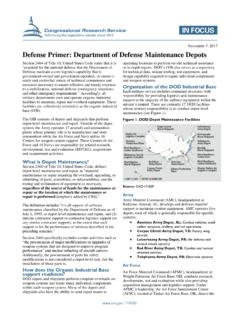Transcription of CLARKSVILLE BASE Fort Campbell, Tennessee
1 Designing, Manufacturing, and Refurbishing the Weapons 379 CLARKSVILLE base fort campbell , Tennessee CLARKSVILLE base fort campbell , Tennessee DURING THE 1950s and early 1960s, while the military had the responsibility for deploying nuclear weapons, the AEC implemented civilian control over their surveillance. This included maintenance, testing, and modification. In a close partnership, the DoD, the AEC, and their contractors conducted nuclear weapon stockpile surveillance at the highly secret CLARKSVILLE base .
2 The Army s fort campbell Military Reservation covered 165 square miles, with about two-thirds in Tennessee and the balance in Kentucky. During 1947 and 1948, the AEC constructed the high-security CLARKSVILLE base within an isolated mile portion of the reservation for the Armed Forces Special Weapons Project (AFSWP). The AFSWP incorporated the military aspects of the wartime MED and operated about 13 facilities on military bases across the nation that performed maintenance work on atomic warheads. The CLARKSVILLE base was also one of the first six of at least 13 National Stockpile Sites that the AFSWP constructed.
3 The other five were located at Barksdale Air Force base (AFB) in Louisiana (Bossier base ), fort Hood in Texas (Killeen base ), Kirtland AFB in New Mexico (Manzano base ), Lackland AFB in Texas (Medina base ), and Nellis AFB in Nevada (Lake Mead base ). The AEC hired the Sandia Corporation to ensure the operational readiness of its nuclear weapons through routine maintenance and quality assurance at several military bases across the country, including the CLARKSVILLE base . The Air Force transferred the 590th Aviation Squadron from Sandia base to CLARKSVILLE in August 1949 to serve as a Special Weapons Assembly Team.
4 In 1952, the Navy took over the operations of the CLARKSVILLE base and secured it with Marines. Toward the end of the 1950s, the Pantex Plant and the Iowa Ordnance Plant had reached their peak capacities and needed assistance to keep up with the increased fabrication and modification workload. In 1958, the AEC re-designated the CLARKSVILLE base as the CLARKSVILLE Modification Center, and constructed the Center s Gravel Gertie maintenance and assembly building. This Gravel Gertie was designed to contain the energy of a 1-kiloton explosion if a worker accidentally detonated a weapon s conventional high explosive.
5 The Defense Atomic Support Agency (DASA), the successor to the AFSWP, selected Navy Captain John Bulkeley, a former boat commander and Medal of Honor recipient who narrowly rescued General Douglas MacArthur from Corregidor during World War II, to lead the military contingent at the base /Modification Center. As a staff member of the Military Liaison Committee to the AEC, Captain Bulkeley was involved with nuclear weapons from late 1949 through 1952. In 1960, the Sandia Corporation discontinued warhead surveillance at this facility, and Mason & Map 8-26 Photograph 8-25 Designing, Manufacturing, and Refurbishing the Weapons 380 Hanger assumed these duties the next year.
6 Following this reorganization, the DoD then began to route additional warheads through Tennessee . Its independent power and water treatment plants made the CLARKSVILLE Modification Center a self-sufficient unit. A pair of chainlink fences, the inner one charged with high voltage, separated The Birdcage from the rest of fort campbell . DASA managed the cone-shaped Gravel Gertie when Mason & Hangar serviced and assembled nuclear warheads, and also maintained seven deep underground tunnel complexes. Each complex consisted of an assemblage of vaults and side rooms along a 600-foot corridor that was protected from above by 10 feet of reinforced concrete and 40 feet of earth.
7 Machine gun-toting Marine guards manned concrete pillboxes here and at six additional underground storage tunnels farther to the west. Large steel bank vault-like doors secured the entrances into these 13 tunnels. DASA used these subterranean shafts as communications centers, civil defense hospital wings, and nuclear warhead storage areas. DASA also conducted communications activities in Building 7877, a formidable, 2-story, concrete-hardened false-windowed structure. Other buildings at the Center housed communications and support services, such as security and the contractor s technical personnel.
8 Warhead surveillance included dismantling the warhead, monitoring the radioactivity of the fissile materials, and replacing the short-lived polonium-beryllium initiators. The secrecy of the old CLARKSVILLE base and its close proximity to the regular Army account for a rich lore of unconfirmed stories. In the early 1960s, Marines fired warning shots at the overly curious pilot of an Army helicopter from fort campbell who attempted to fly over the secret base . Between 1967 and 1969, at least one CLARKSVILLE base trainee electrocuted himself at the high-voltage fencing while going AWOL.
9 The daring Captain Bulkeley periodically tested the security at the CLARKSVILLE base with unannounced lone sorties. For one of his midnight encroachments, he attached a rubber mat to his chest, climbed to the roof of his car, and slid over the top of the electrified fence. fort campbell servicemen were prohibited from having flat tires anywhere near the facility. Even if the car were on its rims, the Marine guards ordered such hapless soldiers to keep moving. In February 1960, five rail cars loaded with Mark-31 nuclear warheads broke loose, rolled down a short grade, and slammed into a bumper.
10 One car derailed, but none of the devices were damaged. The Navy informed the Army of this event, but the Army opted not to issue a news release. In 1965, the AEC transferred nuclear weapon modification duties from the CLARKSVILLE base to the Pantex Plant, and for the next 4 years DASA used the base for storage of classified materials. When DASA discovered a build-up of radon gas in the buildings and tunnels, it shut down the base , declared it surplus, and relinquished it to fort campbell . Since then, various Army units at fort campbell have used the facility, including the 2-17th Cavalry, the 101st Division Support Command, and the covert 160th Designing, Manufacturing, and Refurbishing the Weapons 381 Special Operations Aviation Regiment (SOAR) the black Night Stalkers helicopter group.










